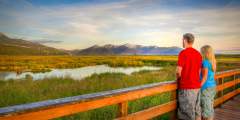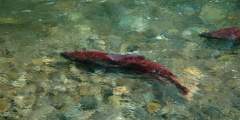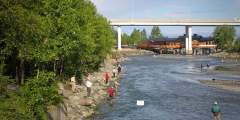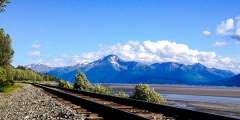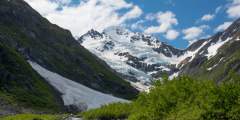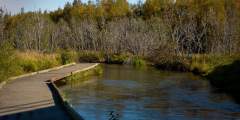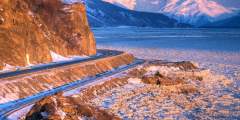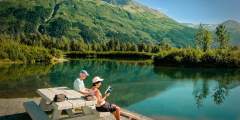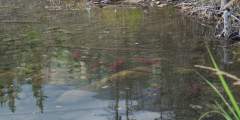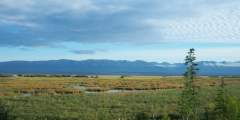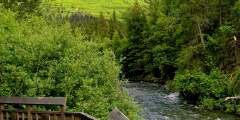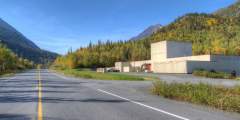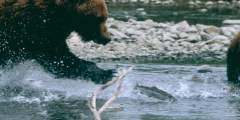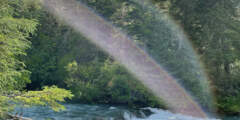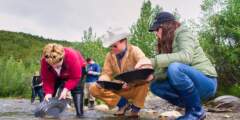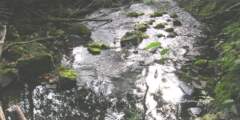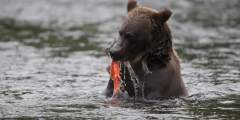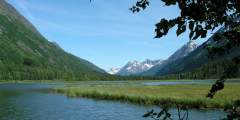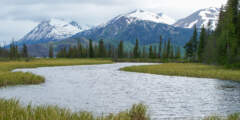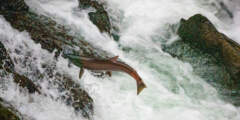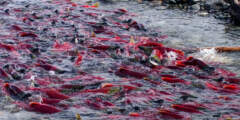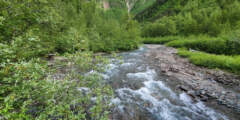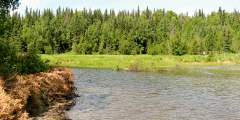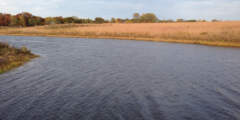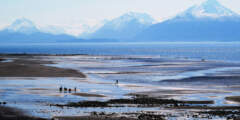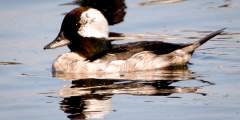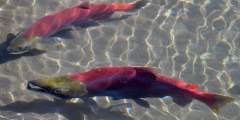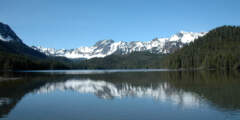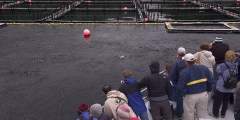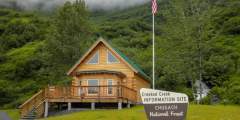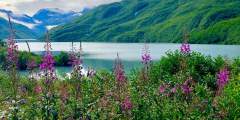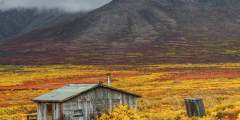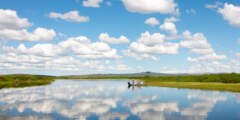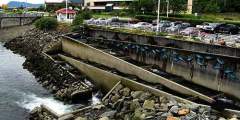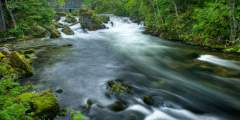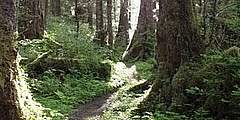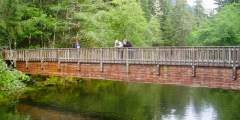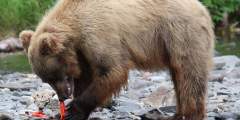Alaska Salmon Viewing Spots
Best Places To See Salmon
Pacific salmon start returning to Alaska during green-up in May and continue to show in some rivers well after leaves have turned in the fall. Gazing down into a channel jammed with fish may be one of Alaska’s most iconic experiences. At the climax of a run, salmon might be arrayed bank-to-bank, like an armada of blushing torpedoes. Further upstream, watching lone fish reach the end of their epic journey can also be awe-inspiring but in a profound and elegiac way. Pairs of decaying spawners swirl and wiggle in crystal water, as females deposit eggs and the males fertilize. Close to death, they have completed one of nature’s great cycles, consuming every bit of strength in their primal mission to reproduce in the waters of their birth. From river mouth to feeder stream, the spawning spectacle is always engrossing.
Jump to: MAP | Anchorage Coastal Wildlife Refuge | Indian Creek | Williwaw Fish Viewing Platform | Tern Lake | Quartz Creek | Russian River | Kenai River | Hatcheries | General Advice | All Locations
Most Popular Spots
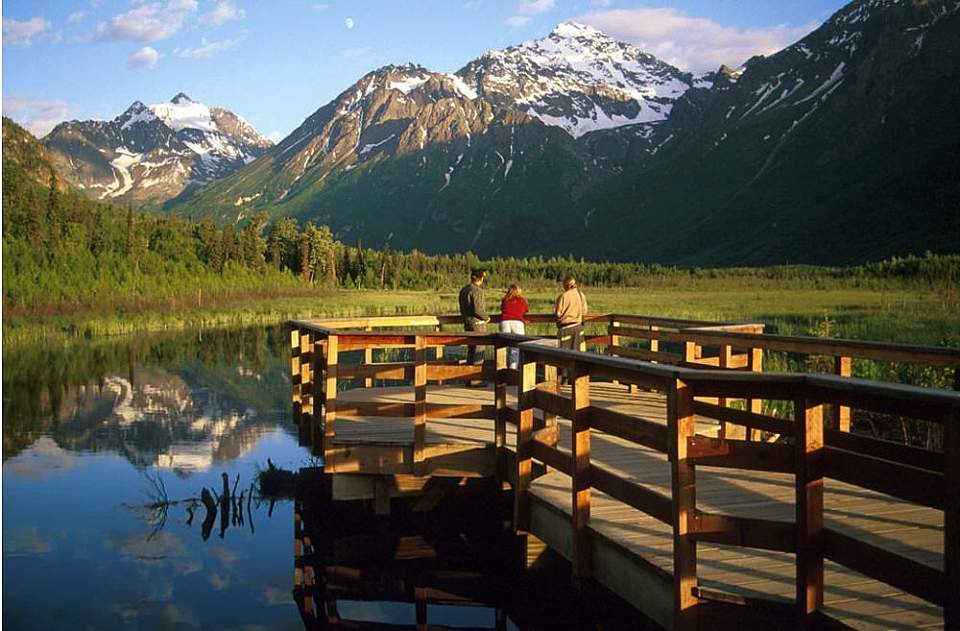
See the action of salmon swimming upriver from the salmon viewing deck at the Eagle River Nature Center.
There are literally scores of good prospects, especially in coastal Southcentral and Southeast Alaska. Pick a link that corresponds to your travel itinerary or destination to find possibilities, and then dial in where to go based on run timing.
Anchorage Coastal Wildlife Refuge – Potter Marsh
20 mins from downtown Anchorage along Seward Highway
Here you'll find one of the most accessible wildlife viewing areas in Alaska with a reliable salmon-watching venue. You’ll often find fish in clear pools right off the 1,550-foot family-friendly boardwalk system. Take the leg that parallels the highway until you reach the channel of Rabbit Creek, from mid-June on. A great place to see giant Chinooks dominate a pool with lesser fish scurrying out of the way.
Indian Creek along Turnagain Arm
30 mins from Downtown Anchorage along Seward Highway
In a classic display of coastal spawning, thousands of pink salmon converge on Indian Creek each July and August. Almost every rising tide from mid-July through August fills this shallow, easy-flowing stream in a wooded park just off the highway. This amazing natural spectacle occurs in one of the safest places to view spawning salmon in the region: No steep banks, crystal clear water and fish so close they could be touched. Bears visit this place, so make noise as you approach.
Williwaw Fish Viewing Platform in Portage Valley
1 hr south of Anchorage via Seward Highway
Located at Mile 4 of the Portage Glacier Highway at the head of Turnagain Arm, this large deck (handicapped accessible) overlooks classic spawning habitat. A bankside trail also winds into the brush with many overlooks that feel wild. These channels feed Williwaw Creek and were enhanced by the U.S. Forest Service decades ago. Spawning sockeye, chum, and coho salmon arrive in late-July and remain throughout early fall with the best viewing in mid to late-August.
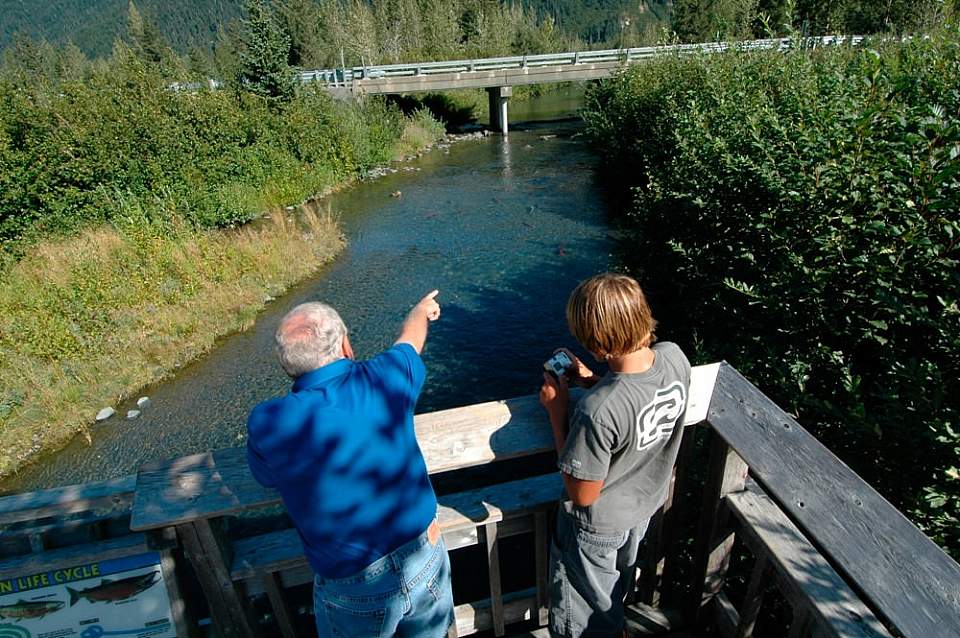
Williwaw Creek offers exceptionally good conditions for watching coho, sockeye and chum salmon spawning in action.
Tern Lake
1 hr 45 mins south of Anchorage on Seward Highway
This productive lake at the junction of the Seward and Sterling Highways about 90 miles south of Anchorage is the final destination for a decent run sockeye salmon. (And a very popular wildlife viewing spot in general.) A day-use picnic area located on the west side of the lake features a wooden deck for viewing spawners in the clear Dave’s Creek from mid-July though fall.
Quartz Creek
1 hr 50 mins South of Anchorage on Sterling Highway
To intercept even more sockeyes further downstream, turn onto Quartz Creek Road at Mile 45 of the Sterling Highway and drive two miles into the campground and park near the creek. Angler’s trails and overlooks will open a window on gobs of famous Kenai reds that are almost home, from mid-July into August.
Russian River
2 hrs South of Anchorage on Sterling Highway
Russian River & Russian River Falls The crystal Russian River attracts two world famous runs of sockeye salmon—in mid-June and July-August—that draw thousands of anglers every summer. It may be the most productive salmon sports fishery in the state. It’s also a great place to see fish. Try the angler’s trail below the U.S. Forest Service campground. Or hike two miles to the Russian River Falls, where a deck affords a view of fish leaping up a cataract in a gorge.
Offbeat idea -Kenai River mouth dipnetting harvest
3 hrs south of Anchorage in the town of Kenai
You won’t see spawning pairs finning in clear water, but you might see hundreds if not thousands of sockeyes hauled ashore in this annual meat fishery reserved for Alaska residents. When the reds run strong, the scene becomes astounding and raw—almost primeval—as people use dipnets to yank fish from the current and then strike them with small clubs before bleeding, gutting or filleting them on the beach. There’s nothing else like it. On a sunny weekend, the beach takes on a carnival atmosphere, with venders, dippers dashing in and out of the water, family groups speaking multiple languages, blood, guts and a couple hundred screaming seagulls. From July 10 to July 31, with peak action during the last 10 days. In Kenai, take Spruce Street to North Beach parking. To avoid congestion, park in the city near the Kenai Visitor Center and walk to the beach down Meeks Trail from Alaska Way.
Guaranteed Viewing – Salmon Hatcheries
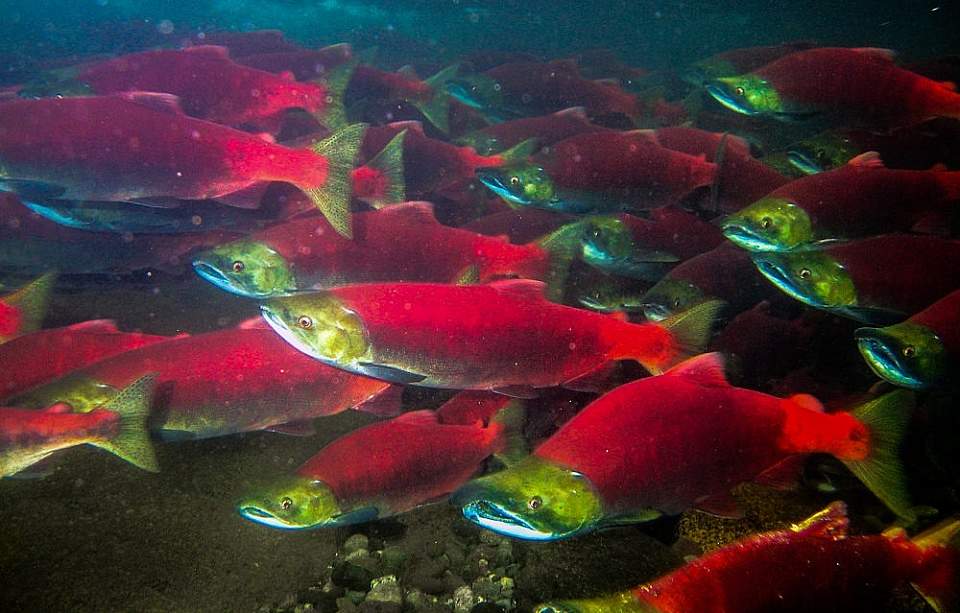
Marvel at the sight of thousands of fish schooling in gigantic tanks by visiting one of the salmon hatcheries.
William Jack Hernandez Fish Hatchery
10 mins from Downtown Anchorage
If you want to marvel at the sight of thousands of fish schooling in gigantic tanks, take the self-guided tour inside the state fish hatchery on the banks of Ship Creek east of downtown. The museum-quality observation deck offers intimate views of a complex operation that produces up to six million sport fish each year.
Macaulay Salmon Hatchery
5 mins from Downtown Juneau
The hatchery raises just over 130 million chum, king and coho salmon annually and is designed to allow visitors see the outside operations of an active hatchery. You'll learn about what it takes to raise salmon, the importance of the Alaska hatchery system, and the near shore marine environment that salmon share with other marine life.
Ruth Burnett Sport Fish Hatchery
5 mins from Downtown Fairbanks
The Ruth Burnett Sport Fish Hatchery stocks arctic char, arctic grayling, rainbow trout, chinook (king) salmon, and coho (silver) salmon in the Fairbanks region. All told, the fish produced by the Hatchery provide fishing opportunities for 137 landlocked lakes located within the Fairbanks, Nenana, Delta and Glennallen regions.
Other Hatcheries
Two state-chartered non-profit corporations operate nine hatcheries that release salmon to augment commercial fisheries in Southcentral Alaska. Two are on the road system (Trail Lakes Hatchery and Gulkana Hatchery), with the others located at remote coastal sites. Depending on staff activity level, visitors can sometimes view salmon in all life stages inside these facilities, through open houses or pre-arranged tours. If you’re in the vicinity anyway, feel free to call to find out what’s possible during your trip.
General Advice
- To see beyond surface glare into the depths, consider wearing polarized sunglasses—the same thing worn by serious anglers.
- Caution, Bears: Bears love to eat salmon and may be present whenever there are fish. If you’re venturing away from developed sites or places with other people, watch for half-eaten carcasses or fresh “bear pies” on access trails. Always follow best practices for hiking in bear country. Travel in a group, make noise and carry bear spray.
Show Map
Salmon Viewing Spots
Anchorage
Here you’ll find one of the most accessible wildlife viewing areas in Alaska. The marsh is a rest area for migratory birds including trumpeter swans, rednecked grebes, golden eyes, and pintails. Also watch for beavers, moose and bald eagles. You may even spot salmon spawning in the deeper water.
If you want to marvel at the sight of thousands of fish schooling in gigantic tanks, take the self-guided tour inside the state fish hatchery on the banks of Ship Creek east of downtown. The museum-quality observation deck offers intimate views of a complex operation that produces up to six million sport fish each year.
For glimpses of the big Chinook salmon right inside the city’s industrial heart, check out the hatchery-seeded run at Ship Creek between late May into June. Hatchery-seeded coho salmon begin running through the same waters in late July through August.
Thousands of pink salmon converge on Indian Creek each July and August, just about filling this shallow, easy-flowing stream south of Anchorage along Turnagain Arm from bank-to-bank. This amazing natural spectacle occurs in one of the easiest places to view spawning salmon in the region: No steep banks, crystal clear water and fish so close they could almost be touched.
Crystal-clear Williwaw Creek and its bank-side trail system in Portage Valley at the head of Turnagain Arm offers exceptionally good conditions for watching spawning in action. Coho, sockeye and chum salmon converge on the creek as it winds through the brushy flats beginning in mid-August, with some late-arriving fish still present after first frost in the fall.
Portage Valley southeast of Anchorage at the head of Turnagain Arm offers so many potential adventures that you might have to tow a trailer loaded with gear to sample them all. What will you find here? Biking, hiking, picnicking, fishing, paddling, wildlife viewing, potential iceberg sightings — plus a natural history visitor center packed with interactive displays about the ecosystem of the valley and Prince William Sound. It’s like an outdoor ...more
This 64.3 acre park has lots to offer with open fields, skijoring trails, a sledding hill, one soccer field, fishing during designated seasons, and a fish viewing platform that is best during the mid to late summer.
The drive from Anchorage to the seaside community of Seward begins with two hours of spectacular views as you pass between the dramatic shorelines of Turnagain Arm and the jutting peaks of the Chugach Mountains.
Located at Mile 1.0 of the Portage Highway, this site has a short boardwalk trail along several ponds. It is a good site for observing waterfowl that nest and rear their young in the ponds and river channels.
Salmon work hard to make their annual appearance at the Eagle River Nature Center’s salmon viewing deck, leaping the abandoned beaver dam, among other obstacles. Over the years, this viewing deck has supported hundreds of photographers capturing moose, bears, eagles, and unparalleled views.
Palmer / Wasilla
Visible outside the windows of the Mat-Su Convention and Visitors Bureau, this state wildlife refuge is the result of the 1964 earthquake. Literally overnight, the land dropped by 6 to 20 feet; hay fields and pastureland became salt flats and marshland. Once home to cows and grains, the land is now prime habitat for moose, birds, and fish. Some 20,000 acres are protected in the refuge, which is a popular recreation and wildlife-viewing… ...more
Seward
This salmon viewing location includes an all-acccessible viewing platform overlooking the creek as well as viewing opportunties along Ptarmigan Creek trail. Sockeye salmon will be in the creek from late July to early October with the best viewing in mid-August. Vehicle parking is in the day use area inside Ptarmigan Creek Campground.
Learn how the fish are raised from small alevin to fry and beyond to smolt size before being released into surrounding lakes and bays. Depending on the fish cycle, there may or may not be fish to view, so please call ahead. If there are no fish to be seen, you’re welcome to look at a small photo gallery and learn about the fish production cycle, and understand why hatchery’s play such an important role in keeping our fish population… ...more
The salmon lifecycle and a working salmon-counting operation is on the menu here, as well as a fresh salmon for your dinner, if you time your visit just right. Hear how!
Great sockeye salmon observation site, especially in late July and early August. At other times of year it offers a moderate walk up to Ptarmigan Lake that’s great for families and features lots of bird life.
From the gravel pullout on the west side of the highway, an easy 1⁄4 mile walk to the Sockeye salmon viewing platform awaits (not fully accessible). Salmon are in the creek from mid-July to early August with the best viewing in late July.
Grouse Creek runs adjacent to the Seward Highway. To access this creek, exit onto the paved pullout at mile 8.3. There’s a Chugach National Forest sign here too that marks the spot. From late- July to mid-September, you will be able to view sockeye salmon with the best chance of seeing fish in mid-August.
Cooper Landing
Learn how the fish are raised from small alevin to fry and beyond to smolt size before being released into surrounding lakes and bays. Depending on the fish cycle, there may or may not be fish to view, so please call ahead. If there are no fish to be seen, you’re welcome to look at a small photo gallery and learn about the fish production cycle, and understand why hatchery’s play such an important role in keeping our fish population… ...more
This wildlife sweet spot is worth a visit. The Russian Lakes Trail begins off the access road to the Russian River Campground in Cooper Landing, at milepost 52 of the Sterling Highway. Get off-the-beaten path, hike two miles to the falls and enjoy the immediate reward of spectacular salmon viewing.
This is a day use site that offers 13 picnic sites with tables, a fish viewing platform, water, toilets, an information board, and fire grates.
This salmon viewing location includes an all-acccessible viewing platform overlooking the creek as well as viewing opportunties along Ptarmigan Creek trail. Sockeye salmon will be in the creek from late July to early October with the best viewing in mid-August. Vehicle parking is in the day use area inside Ptarmigan Creek Campground.
Viewing is easy due to the all-acccessible viewing platform and streamside trail. Sockeye, chum, pink, and silver salmon will be visible August — November
Thousands of sockeye salmon migrate up Hidden Creek each year in late July and early August. With salmon come bears to feed on them. As you drive through this area, you may be able to spot bears at the Skilak Road crossing of the creek near the Hidden Lake Campground turnoff.
Look for the Russian River Campground (entry fee required) and park in the day-use parking areas within campground facilities. A two mile well-maintained gravel trail leads to the viewing platform above the falls or to the angler trail along the river. Use caution for high densities of brown and black bears who are fishing for the same Sockeye and Coho salmon you are looking for. Salmon are in the river mid June through September with the… ...more
From the gravel pullout on the west side of the highway, an easy 1⁄4 mile walk to the Sockeye salmon viewing platform awaits (not fully accessible). Salmon are in the creek from mid-July to early August with the best viewing in late July.
Sounds Wild: Trees Need SalmonAs you drive toward Soldotna you will see the Kenai River on your left. This river has thousands of salmon spawning in it each year. Mostly sockeye or red salmon but also coho or silver salmon, chinook or king salmon and pink or humpy salmon. After these salmon die, they float downstream and are deposited along the riverbank where they decompose and provide food to the riverside plants.More Information ...more
Turn on Quartz Creek Road and proceed 2 miles to Quartz Creek Campground. The stream is adjacent to the picnic area and a trail expands Sockeye and Coho salmon viewing opportunities upstream or downstream. Salmon viewing takes place from late July to early October with best viewing in early August.
Kenai / Soldotna
Slikok Creek passes under Kalifonsky Rd. and fish can be seen spawning near the culvert on both sides of the road. This is a critical habitat area and you are asked not to wander along the banks of this very sensitive stream. All viewing can be done next to the road. Best salmon viewing months are June and early-July.
Walk out to the boardwalks along the Kenai River, learn about riverine habitat and the salmon lifecycle, and witness the timeless dance of hunter and hunted, of fish and fisher. One year-round resident here will impress you with their winter survival skills.
Izaak Walton State Rec Site near Sterling offers 31 campsites at the junction of the Kenai and Moose Rivers on Alaska’s Kenai Peninsula. Managed by Alaska State Parks, it features spruce surroundings, river access, a boat launch, vault toilets, and fire rings. Named after famed angler Izaak Walton, it’s ideal for salmon fly-fishing, exploring archaeology, and enjoying the Kenai’s scenic beauty.
Thousands of sockeye salmon migrate up Hidden Creek each year in late July and early August. With salmon come bears to feed on them. As you drive through this area, you may be able to spot bears at the Skilak Road crossing of the creek near the Hidden Lake Campground turnoff.
The trail is half a mile long and takes you through a mature birch forest that is carpeted with devil’s club and watermelon berry plants. It’s an easy walking, ideal for small children, and ends at a small camping area on a slight bluff that overlooks Bishop’s Beach and Bishop Creek.
Stretch your legs here and check out one of the favorite rest stops for thousands of Kenai River salmon on their journey home. We’ll also seek out giant trumpeter swans, red-necked grebes, and of course, fishers of another species — humans. Here at the confluence, the two rivers reveal their source waters in a very clear visual demonstration.
Prince William Sound & Copper Basin
This is an undeveloped site that provides viewing opportunities of Sockeye salmon from Power Creek Road — four miles northeast of Cordova. Salmon will be in the creek from early July to mid-August with the best viewing in mid to late July. There is parking where the creek passes under the road. Photo: Wendy Ranney
While on the highway look for the McKinley Lake Cabin sign and trailhead. From the trailhead, a 2 1⁄2 mile hike will take you to the Forest Service public cabin. Sockeye salmon viewing opportunities exist here and at the location another 75 yards past the cabin. Salmon viewing at this location is from mid July to mid August with best viewing in late July or early August.
Look for the channel to a beaver pond. The channel provides access to the pond for silver salmon fry and can support up to 25,400 young salmon. The fallen trees and brush provide cover from predators. Here you will also find access to Saddlebag Glacier USFA Trail, a 3‑mile trail to Saddlebag Lake, this is the best trail for mountain biking in the district.
This remote site is six miles north of Cordova on the east shore of Nelson Bay and is accessible by boat. Most spawning occurs with pink and chum salmon in intertidal areas and a short distance upstream. Best viewing times are mid-July through late August with best viewing in early August.
Shrode Creek is at the head of Long Bay on the west side of Culross Passage on Prince William Sound. This remote site is accessible by boat or plane. A one mile trail follows the river from the head of Long Bay to Shrode Lake where you will find sockeye, chum, pink, and coho salmon. Salmon are present from mid-July to mid-September with the best viewing in mid-August. A nearby Forest Service public cabin is available for reservations. ...more
Harrison Lagoon is on the west side of Port Wells in Prince William Sound and is accessible by boat. The stream enters on the north side of Harrison Lagoon with pink and chum salmon in it. Best viewing times are late July though late August with best viewing in mid-August. A nearby Forest Service public use cabin is available for reservations.
The Alaska Department of Fish & Game operate the Crooked Creek hatchery, adult salmon may be viewed moving up the stream and fishway into the hatchery raceways; king salmon in late June and early July and coho salmon in late August and September. Each salmon is identified and counted as it swims through the chute using an underwater video camera.
This remote site is accessible by boat or floatplane. Chalmers River is located about 3⁄4 mile north of a Forest Service public cabin on the northwest side of Montague Island in Prince William Sound. Spawning Pink and Chum salmon can be seen in the intertidal areas and a short distance upstream. Best salmon viewing times are late July through August with peak times in mid-August.
See saltwater holding pens full of fish fry (young ones) waiting to be released into the ocean. In June and July, the water boils with swirling fish, eagles perch in almost every tree, and commercial purse-seiner fishermen capture surface fish by encircling them in long nets.
Operated by the U.S. Forest Service and open only in summertime, it’s staffed by guides who can help you understand the area. There’s also a stream that runs thick with pink and chum salmon when they return each summer to spawn. Thanks to a footbridge over the stream and the clear Alaskan water, it’s easy to see the fish. (The best viewing is from mid-July through October.) You may also see black bears, who come to feast on the fish.
Fairbanks & Interior
The Ruth Burnett Sport Fish Hatchery stocks arctic char, arctic grayling, rainbow trout, chinook (king) salmon, and coho (silver) salmon in the Fairbanks region. All told, the fish produced by the Hatchery provide fishing opportunities for 137 landlocked lakes located within the Fairbanks, Nenana, Delta and Glennallen regions.
The China River flows through Fairbanks and is home to both king and chum salmon. This fish weir on the Chena is used by state and federal agencies to count the number of returning salmon.
The Gulkana Hatchery is a state-owned hatchery established in 1973 by the ADF&G. By 1984, Gulkana became the largest sockeye fry production facility worldwide, with egg volumes of 26 million.
Nome
The Nome River is a good place to see salmon. Pink and chum salmon spawn in August, coho are usually present in August and September. Sockeye salmon, Arctic grayling, and Dolly Varden may be present. Look for Arctic terns fishing, harlequin duck and red-breasted merganser riding swift water, spotted sandpiper or wandering tattler at waterline, and northern shrike in the willowed river edges.
Descending into terrain increasingly dominated by trees and willows, you are more likely to see a moose than a muskox. In late summer grizzlies feed on spawning chum salmon below the Fox River bridge. Salmon carcasses also attract red fox, gulls, and common ravens. Both abandoned and active beaver lodges and dams are found along the Fox River drainage. Dolly Varden, Arctic grayling, and chum and pink salmon can be seen from the bridge. ...more
An old road bed leading to a Solomon River overlook is a good spot to look for salmon, Dolly Varden, and Arctic grayling in late July and August. Say’s phoebe will launch from its nest to catch insects. Northern shrike, harlequin duck, spotted sandpiper, and wandering tattler are also seen. In some years, the cliff is occupied by common raven, rough-legged hawk, or other raptors so be careful your presence does not disturb nesting birds.
Sockeye salmon migrate up Pilgrim River to Salmon Lake between late July and mid-August, and some continue up the Grand Central River as far as the bridge. Grizzlies are fairly common in late summer when spawned-out salmon and ripe berries are abundant. Birders watch for harlequin duck, red-breasted merganser, American dipper, Bluethroat, yellow warbler, Wilson’s warbler, and Arctic warbler.
The steep road grade on either side of Cripple River gives a good overview of the thin thread-like river that runs through the valley. Gold mining activities occurred in the upper tributaries, as evidenced by the road and horizontal ditch lines. Look for harlequin ducks paddling swift river currents in late August or September, and Pink Salmon swimming upstream to spawn.
The Pilgrim River crossing brings you close to groves of cottonwood that are abundant in this section of the valley. Look for spawning salmon, moose, and a variety of birds.
McCarthy
Stop at Long Lake, at mile 45.2, to see a popular spot for sockeye salmon to spawn. Every year, 18,000 sockeye salmon swim up the Chitina and Copper Rivers to spawn in Long Lake. This is a very unique run, salmon begin entering the lake as late as September and spawn until April.
Juneau
Steep Creek is a Forest Service fish viewing site, with runs of sockeye and coho salmon that start in mid-July and continue into October. The site is very easy to visit. It is adjacent to the Mendenhall glacier visitors’ center about 10 miles from downtown Juneau. There are no permits, fees or restrictions for the visitation. There’s a 1⁄3 mile loop trail, part of which forms an elevated boardwalk.
The hatchery raises just over 130 million chum, king and coho salmon annually and is designed to allow visitors see the outside operations of an active hatchery. You’ll learn about what it takes to raise salmon, the importance of the Alaska hatchery system, and the near shore marine environment that salmon share with other marine life.
Ketchikan
In the town that boasts of being the Alaskan salmon capital of the world, here’s where you can see the salmon in action — hundreds of thousands come through every summer. This spot, right next the library and at the end of Creek Street, offers a prime view of the crowds of salmon on their way to spawn.
Sitka
The Indian river is home to a number of fish: Summer Pink, chum, coho, chinook salmon, along with Dolly Varden, char, and steelhead trout. This arched bridge is the place to see them. Be sure to stop by on your way through Alaska’s oldest designated National Park.
The Indian River is a beautiful, clear stream that’s home to spawning salmon each summer. On the lower reaches of the river, by the intertidal zone and lower floodplain, pink and chum salmon spawn from mid-July through September. Farther up the river, you’ll find coho and chinook salmon, Dolly Varden, char, and steelhead trout.
This is a great, easy walk that can be linked to the Forest and Muskeg Trail and Mosquito Cove Trail. The boardwalk trail travels through a rich tidelands ecosystem, where you’ll find good bird watching for shore and seabirds. You may even spot bears, who show up here to feed on young grasses in early summer and return in mid-July to the end of September for the pink and silver salmon runs. The U.S. Forest Service manages the area, and the… ...more
Kodiak
During August and September, the ditch on the left of the Chiniak Highway at MP 29.0 becomes an active spawning area for salmon.
The trail parallels Island Lake Creek, which tumbles steeply through the woods over falls and boulders. This is a good place to see dippers, as well as forest birds such as winter wrens, varied thrush, chickadees, nuthatches and creepers.
From this bridge on Kodiak’s Chiniak Highway it’s possible to see spawning salmon in August and September. There’s also potential to see brown bears here during the late summer as they feast on salmon, especially around dawn or dusk. The road on the south side of the bridge leads to Bell’s Flats.
Hundreds of pink salmon run up this creek during the summer. You can watch them at the culvert as hundreds of them hurry past on their way to spawn. Peak times for viewing is mid-July to late-August.
This is a very scenic and easy hike with great birding and flower viewing. During April and early May this is a prime location to view migrating gray whales. Check out all of the rocky outcrops, beaches and offshore waters for birds. Look for bank swallows nesting in the sea cliffs and harbor seals lounging on the rocks.
Look for salmon and bald eagles here.

